| |
 |
 |
 |
 |
GLENN
CONNER
|
 |
Tonight's demo is a set of Ice Creepers.
|
 |
GLENN
CONNER
|
 |
For the history part, the ice creepers were held to the instep by a leather strap. These were made and worn in the 1760-1777 era and Revolutionary War time. They were used because of the rough country in America, and the frozen waterways were often used as a means of travel.
|
 |
GLENN
CONNER
|
 |
Start with a piece of metal (mild steel) 1-1/2" x 6" x 3/8" or 1/4" thick. This fits my 3" wide instep. The formula I used for measuring was width of the shoe instep, plus 3". Slight adjustment may be needed to fit your shoe.
|
 |
 |
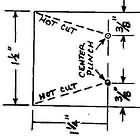
Figure 00 |
Mark 2 lines, one 3/8" parallel to the length and the other 1-1/4" from the end. Mark this intersection point with a center punch.
|
 |
 |
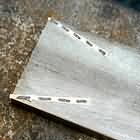
Figure 01 |
This will be the the end point of the hot cut line from the intersection to the corner of the metal.
|
 |
 |
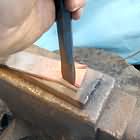
Figure 02 |
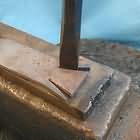
Figure 03 |
 |
 |
GLENN
CONNER
|
 |
Hot cut this line on each side and spread the kerf a little.
|
 |
 |

Figure 04 |
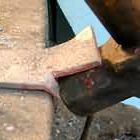
Figure 05 |
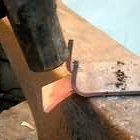
Figure 06 |
 |
GLENN
CONNER
|
 |
Bend the points down and straighten on the side of the anvil.
|
 |
 |

Figure 07 |
Punch a hole that will fit the size of the leather strap used. I used 1/2" for a leather lace. Repeat the process on the other end of the metal.
|
 |
 |
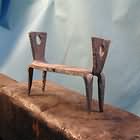
Figure 08 |
It is most important to file ALL the metal edges of the loop section round and smooth. If not smooth, it WILL cut the leather holding strap. When fitting the creeper to the shoe, check to be sure the loop section does NOT rub against the shoe.
|
 |
 |
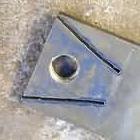
Figure 09 |
For the non-traditionalists, a hack saw or plasma cutter will work instead of the hot cutter. A drill will work instead of the punch.
|
 |
 |
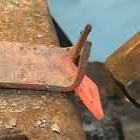
Figure 10 |
The bending is the same. Feet go down and the loops goes up.
|
 |
 |
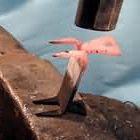
Figure 11 |
For the feet, sometimes it helps to put the creeper on end and use the hammer to get good 90 degree bends at the end of the cuts.
|
 |
 |

Figure 12 |
This will give a spike that is about 1" long. It will wear some with use, and can easily be sharpened in a forge or with a file. My instep is 1/2" to 3/4" deep so that leaves about a 1/2" of spike to grip into the ice or snow. The spike length can be adjusted to your weather, a bit shorter for ice, a bit longer for snow.
The leather strap ran from the front, through the inside loop, around the back, through the outside loop and tied in the front. That way it holds the creeper to the foot better.
|
 |
 |

Figure 12 |
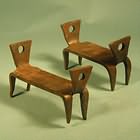
Figure 13 |
 |
 |
GLENN
CONNER
|
 |
The entire project takes 45 minutes, the first time. If it prevents one fall, it is time well spent.
|
 |
GLENN
CONNER
|
 |
Questions?
|
 |
|
 |
Great demo Glenn..splendid pics too!
|
 |
Nan
|
 |
Thanks!!!
|
 |
Pablo27
|
 |
Great Demo, excellent pictures. Do the Revolutionary War re-enactors but them?
|
 |
Dave L
|
 |
Well Done Glen Thanks Could they be done from stainless as well?
|
 |
pigsmith
|
 |
Looks pretty straightforward to me. Nice demo!
|
 |
Ten
|
 |
Glenn, these are very handy at times. I got a store bought pair, and will make a pair too. Thanks !
|
 |
RLD
|
 |
good pics Glen
|
 |
jerry
|
 |
Glenn, bought a pair dang near like yours at Friendship, Ind. 20 years ago--still usable!!
|
 |
GLENN
CONNER
|
 |
Revolutionary Was re-enactors should buy them. It is from that period.
|
 |
gypsy
|
 |
thx, glenn,great demo!!!:)
|
 |
GLENN
CONNER
|
 |
Stainless should work also.
|
 |
Tony P
|
 |
Great demo Glenn !!
|
 |
jerry
|
 |
need snow shoes here now!!
|
 |

